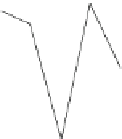Geology Reference
In-Depth Information
(0.7076) and kivite (0.7067) have higher
87
Sr/
86
Sr ratios than feldspathoid-bearing
katungite (0.7047), leucitite and mafurite (0.7050).
Ultrapotassic lavas from the western branch of the East African Rift display
similar Pb isotope characteristics, although with a wider range of
207
Pb/
204
Pb ratios,
overlapping with the MORB-OIB
field, suggesting that they may have experienced
some crustal contamination.
5.3 The Rare Earth Element and Trace Element
Geochemistry of Lamproites from Western Australia,
Leucite Hills (U.S.A.) and Gaussberg (Antarctica)
Nelson et al. (1986) compared trace element geochemistry of potassic rocks from
Western Australia (McCulloch et al. 1983; Neslon et al. 1986; Jaques et al. 1984),
Presley Peak and Gaussberg (Antarctica, Sheraton and England 1980; Sheraton and
Cundari 1980) and Leucite Hills (Kuehner et al. 1981; Volmer et al. 1984). The data
compiled by Nelson et al. are summarized in Fig.
5.7
, where the trace element
geochemical pattern involving such elements as Pb, Rb, Ba, Th, U, K, Nb, La, Ce,
2000
anorogenic ultrapotassic magmatism
1000
500
300
200
100
50
30
20
10
5
slates
pelagic mud composite
3
2
Pb
Rb
Ba
Th
U
K
Nb
La Ce
Sr
Pr
Nd Zr
S
Ti
Y
Fig. 5.7 Trace element patterns normalized to estimated primitive mantle (abundances of average
potassic magma) hatched (from Western Australia) (McCulloch et al. 1983; Nelson et al. 1986;
Jaques et al. 1984; Nixon et al. 1984), Priestly peak and Gaussberg, Antarctica (Sheraton and
England 1980; Sheraton and Cundari 1980) and Leucite Hills (orendites and wyomingites from
Kuehner et al. 1981; Volmer et al. 1984) compared with some examples of modern sediments
(Thompson et al. 1984; after Nelson et al. 1986)


























































































































































Search WWH ::

Custom Search